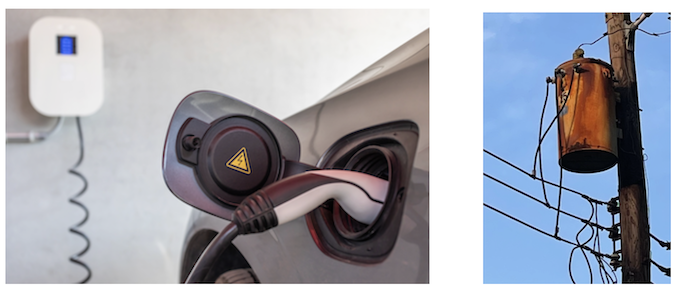High Tech Meets Low Tech

That’s not my car, but that’s an actual distribution transformer in my neighborhood. I think the utility company got a good return on its investment in that transformer. (It’s probably been there for 40+ years. It doesn’t inspire confidence in the grid.)
An electric vehicle (EV) and its charger are representative of extreme high tech. The distribution transformer is a low tech dumb device – it operates on the basic principles of electromagnetism. However, the electric utility grid upstream of the transformer is extremely complex, and is becoming more high tech than ever.
As EVs and increased electrification of homes create more load, the neighborhood grid will need capacity and operational improvements. Who pays for those improvements and what form they’ll take are questions that remain to be answered.
Shared Pain Ahead?
A typical neighborhood distribution transformer might supply two to three homes. The transformer in the picture, along with two others, serve eight homes in my neighborhood.
Some larger EV chargers can consume up to three times the normal peak electrical demand of an average home. From an operations and planning perspective, a few of these chargers added to a typical neighborhood distribution system can be a nightmare for an electric utility. The trend towards more electrification in homes futher compounds the problem.
If neighborhood distribution systems are not improved in a timely manner, it will result in problems for all residents sharing the system. Examples include:
- Voltage variations outside the acceptable operating range
- Power outages due to grid distribution equipment protective device operations or equipment failures
- More frequent requests for voluntary load curtailment
In communities everywhere, discussions are taking place about how to meet this challenge. In some locations, utilities are lobbying for legislation to place all or part of the financial burden for grid improvements on consumers. From a consumer perspective, this makes little sense since utilities will profit from the increased demand for their product. Also, there’s an argument that since wealthier individuals will likely have EVs before poorer individuals, any costs passed along to consumers will hurt the poor disproportionately.
Solutions Involve Trade Offs
If you think of an EV as a potential source of stored energy, rather than just a load that consumes energy during charging, the EV can be a valuable tool in grid management. Taking advantage of this potential energy source involves communications between EVs, electric grids, and people.
To facilitate electrical systems communications, vehicle-to-grid (V2G) initiatives are in development. From a people perspective, utilities will want to control when EVs can charge or provide energy to the grid for demand response flexibility, but consumers will want to control when they consume or sell energy to the utility. So, there’s a built-in conflict between the supply and demand sides of the equation.
EVs Flexibility
EVs can be fitted with bidirectional chargers. These charges can consume energy while charging the EV battery or can supply stored energy from the battery to the electric grid or local loads. Some examples of flexible operating modes:
- Charge the EV at times when electric grid demand is low
- Charge the EV via a sustainable energy source such as wind or solar
- Supply local energy to a home during power outages or times of high demand on the electric grid
- Sell power to the electric grid operator (help reduce the cost of ownership of the EV) [1]
- Sell power to a building or parking garage owner/operator
Lay Some Groundwork Now
There are steps all parties can take now that will increase the probability of successful integration of EVs and neighborhood grids in the future.
Utilities
- Develop grid improvement plans and provide transparency regarding costs and potential revenue
- Agree upon standardized communications protocols between grid operators and EV bidirectional chargers. IEC/ISO standards, for example, are gaining acceptance. [2]
- Propose realistic policies for interaction with consumers so that V2G energy flow can work for everyone
EV Manufacturers
- Standardize on configurations for EV charging plugs and receptacles (avoid and abandon proprietary designs). UPDATE 07/03/23: In late May, Ford announced plans to adapt Tesla’s NACS proprietary charging plug starting in 2025, with adapters being made available to access Tesla’s charging network in early 2024. In early June, GM made a similar announcement. On June 27, 2023, SAE International, an automotive standards organization, announced it would develop a standard based on NACS on an expedited basis.
- Standardize communications protocols and basic application programming interfaces for V2G systems
Individuals
- Let your opinions be known via communications with legislators, policy makers and public utility regulatory agencies
- Advocate for neighborhood grid improvements planning now instead of later
- Be realistic about policies for V2G interaction. Whatever policy evolves, it will probably require some give and take between all parties.
[1] NC Cooperative Demonstration of Vehicle-to-Grid Smart Charger Concludes with Positive Results, May 8, 2023 https://nccleantech.ncsu.edu/2023/05/08/nc-cooperative-demonstration-of-vehicle-to-grid-smart-charger-concludes/
[2] ISO (the International Organization for Standardization) and IEC (the International Electrotechnical Commission), ISO 15118-20:2022 Road vehicles — Vehicle to grid communication interface — Part 20: 2nd generation network layer and application layer requirements (online browsing preview – not the full standard)
https://www.iso.org/obp/ui/#iso:std:iso:15118:-20:ed-1:v1:en
For further reading:
Federal Energy Management Program, Bidirectional Charging and Electric Vehicles for Mobile Storage
SAE WCX 2023: Sorting out EV public charging in the U.S. by Kami Buchholz, May 2, 2023
